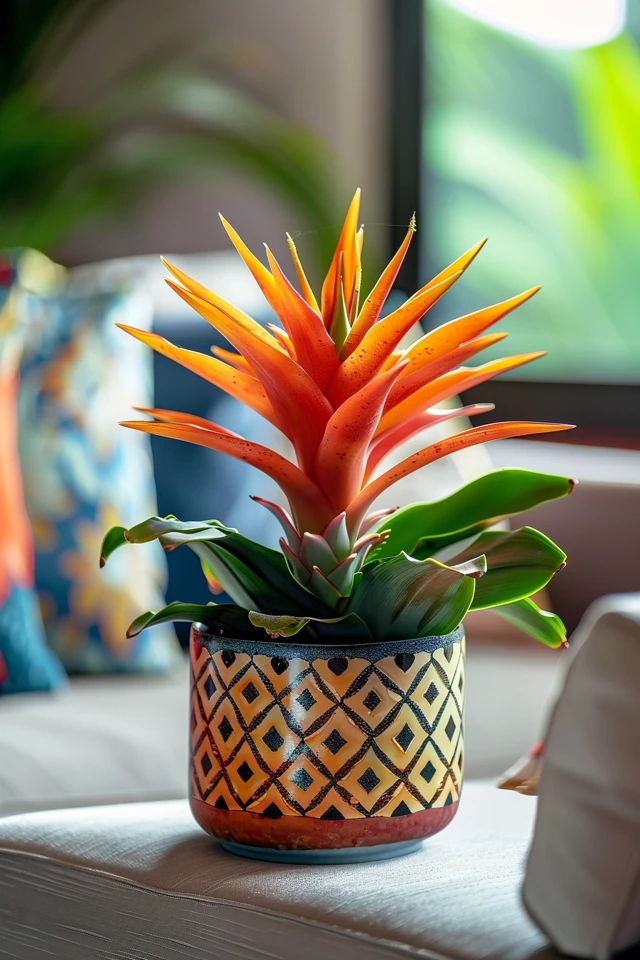Repotting bromeliads is an essential step in ensuring their healthy growth and vitality. Proper repotting techniques can promote better root development, prevent overcrowding, and rejuvenate the plant. In this section, I will guide you through the step-by-step process of repotting bromeliads and provide valuable care tips for their optimal growth.
Key Takeaways:
- Repotting bromeliads is crucial for their healthy growth and vitality.
- It promotes better root development and prevents overcrowding.
- Repotting rejuvenates the plant and encourages new shoots and blooms.
- Inspect the root health and remove any damaged or diseased portions during repotting.
- Provide proper care to ensure the continued growth and well-being of your bromeliad.
The Importance of Repotting Bromeliads
Repotting bromeliads is an essential aspect of their care that should not be overlooked. The process of repotting provides numerous benefits for the plants, ensuring their continued growth and well-being. Here are key reasons why repotting bromeliads is important:
- Better Root Development: Bromeliads have small root systems and prefer to be slightly root-bound. Repotting allows the roots to have enough space to grow and prevents them from becoming overcrowded. This promotes optimal root development, which in turn supports the overall health and vitality of the plant.
- Promotes Healthier Growth: Repotting bromeliads provides an opportunity to rejuvenate the plant and promote healthier growth. By replacing the old soil with fresh, nutrient-rich soil, you provide the bromeliad with the necessary resources for thriving. The new soil also delivers essential nutrients to the roots, encouraging the development of new shoots and blooms.
- Root Health Inspection: Repotting allows you to examine the health of the plant’s roots. By carefully inspecting the roots, you can identify and remove any damaged or diseased portions, preventing the spread of diseases and ensuring the overall well-being of the bromeliad.
Overall, repotting bromeliads is a crucial part of their care routine. It promotes optimal root development, rejuvenates the plant, and helps maintain its overall health.

Step-by-Step Guide to Repotting Bromeliads
Repotting bromeliads is a simple process that can help ensure the health and longevity of your plants. Follow these step-by-step instructions to repot your bromeliads successfully:
- Select the right time: Choose a time when your bromeliad is not actively blooming or growing. Spring or early summer is usually a good time to repot bromeliads.
- Prepare the new container: Choose a container that is slightly larger than the current one. Make sure it has drainage holes at the bottom to prevent waterlogging. Fill the container with a well-draining potting mix suitable for bromeliads.
- Remove the bromeliad from its current pot: Gently loosen the roots of the bromeliad by tapping the sides of the pot. Carefully remove the plant, holding it by the base or leaves to avoid damaging the delicate roots.
- Inspect and trim the roots: Examine the roots for any signs of rot or damage. Trim off any dead or unhealthy roots using clean, sharp scissors or pruning shears. This will promote healthy growth and prevent the spread of diseases.
- Place the bromeliad in the new container: Position the bromeliad in the center of the new container, ensuring that the base of the plant sits just above the soil level. Add more potting mix around the sides, gently pressing it down to secure the plant in place.
- Water the bromeliad: Give the repotted bromeliad a thorough watering until the excess water drains out through the bottom. Avoid overwatering, as bromeliads are susceptible to root rot. Allow the soil to dry slightly between watering sessions.
- Provide the right conditions: After repotting, place your bromeliad in a location with bright, indirect sunlight. Avoid direct sunlight, as it may scorch the leaves. Maintain a warm temperature of around 70-80°F (21-27°C) and provide adequate humidity by misting the leaves regularly.
By following this step-by-step guide, you can successfully repot your bromeliads and provide them with the ideal conditions for healthy growth.

Tips for Bromeliad Care After Repotting
After repotting your bromeliad, it’s crucial to provide the proper care to ensure its continued growth and well-being. Here are some essential tips to keep in mind:
1. Use the best soil for bromeliads: Choose a well-draining soil mix specifically formulated for bromeliads. This type of soil allows for proper airflow and prevents waterlogging, which can lead to root rot.
2. Monitor moisture levels: Bromeliads prefer moderately moist soil. It’s important to strike the right balance by allowing the soil to dry out slightly between waterings. Use your finger to check the moisture level, and only water when the top inch of soil feels dry.
3. Provide adequate light: Most bromeliads thrive in bright, indirect light. Place your repotted bromeliad in a location where it can receive bright, filtered sunlight for a few hours each day. Avoid placing it in direct sunlight, as this can lead to leaf burn.
4. Maintain optimal humidity: Bromeliads are tropical plants that appreciate a humid environment. To increase humidity levels, you can place a tray filled with water near the bromeliad or use a humidifier.
5. Feed regularly: Bromeliads benefit from regular feeding to obtain essential nutrients. Use a balanced, water-soluble fertilizer specially formulated for bromeliads, following the manufacturer’s instructions regarding dosage and frequency.
6. Keep an eye out for pests: Monitor your bromeliad for any signs of pests such as mealybugs or spider mites. If detected, treat the infestation promptly using organic pest control methods or insecticidal soap.
By following these care tips after repotting, you can ensure that your bromeliad remains healthy, vibrant, and continues to thrive in its new pot. Remember, each bromeliad species may have specific care requirements, so it’s always helpful to research the needs of your particular variety for optimal care.


